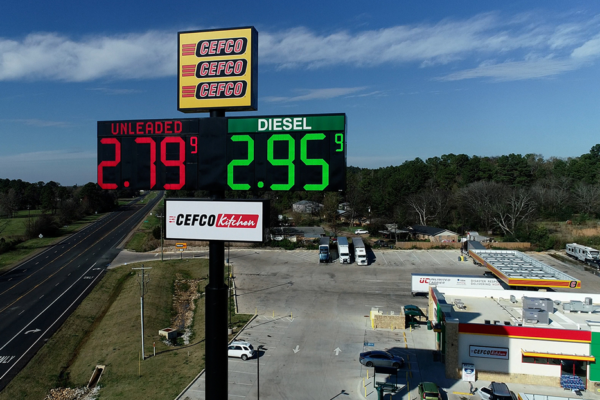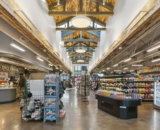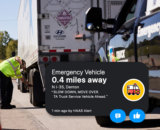Article created for the digital issue of
Outdoor signage at truck stops and travel centers can enhance the customer experience, provide direction, convey essential information, and build the company's brand.
“As customers come onsite, what do they see and how does it make them feel? The big thing is to develop a master plan and create brand and signage standards,” said Mike Lawshe, CEO of Paragon Solutions, a NATSO Chairman Circle member. “When every sign is a different size, font or color, it is confusing.”
Lawshe explained that signage needs to have a purpose. "Go through and say, ' Do I need that sign? ' Is it accomplishing my goal, and what is my goal?'"
Capturing Drivers’ Attention
A fuel price sign is essential and is often the first thing potential customers see. “They are the very first touchpoint that a store has with a potential customer, which is why legibility and reliability are key features to look for in a sign,” said Melissa Archibald, marketing content and events manager for Skyline Products. (See a sign by Skyline Products at CEFCO above.)
Darren Schulte, vice president of membership for NATSO, recommends having signs that display cash and credit prices for diesel. He also suggests using the company logo at the top of the sign and lighting it. "Any other information that you feel critical should be under your logo and the price of fuel. Your customer should always know that they are at your location first and foremost. Your brand should be front and center" he said.
A common trend Skyline Products is seeing is the ability to alternate price tiers. "It is more than cash and credit, but a branded tier like member prices, etc.," Archibald said, adding that Skyline has a solution that allows its customers to use custom messaging on its price tier and change messaging on the fly.
In addition to alternating price tiers, Archibald said operators are looking to alternate products on a single display. This would allow them to use larger digits in the same area of the sign while giving them the ability to display multiple commodities. Durability, low cost of ownership and software integrations are important considerations. “Custom solutions are also key,” she said.
Functionality is a top consideration, and Archibald recommends operators look for signs that provide the ability and control to change prices manually using either a handheld controller, automatically through the site's point-of-sale system or directly from its software. "The communication methods that these utilize from the store to the signage can either be hardwired, short-range radio, long-range radio or IP cell," she said.
Since price signs are the first touchpoint, uptime is essential. Skyline offers PriceAdvantage, which actively monitors the signs for faults or errors. "If a fault is detected or an incorrect price is displayed, the sign will immediately notify you which digit is reporting an error through the handheld controller located inside the store," she said.
If locations have DEF available at the pump and scales available, Schulte recommends operators note it on billboards, Google and the fuel canopy, but said it isn't needed on a high-rise sign. "As trucks enter, you can have other signage that denotes that, such as a monument sign," he said.
Giving Customers Direction
In addition to high-rise signs, locations can add monument signs, street-level price signs and directional signs. Finding the right mix of sign solutions is unique to each location.
When determining the types of signs to add, Archibald recommends operators consider sight lines for major highways and intersections. "Does your traveler need to be able to see the sign from miles down an interstate highway? You might consider a 10-foot-tall LED sign solution. For local street traffic, you can cut through some of the visual noise with clean, bright, eye-catching monument and canopy signs advertising prices," she said.
Thinking through the customer experience can help operators determine what is needed. "Entry and exit for trucks should be clearly defined for all your customer types, and they should be raised so that a professional driver can see them," Schulte said. "Often, they are placed at heights that only cars can see. Keep in mind the customer you are trying to communicate with your sign program.”
Informational signage can help locations sell more products and can be digital or stagnant. Schulte said digital signage allows operators to attract, engage and connect with customers in ways that written and static-marketing signage cannot. “As consumers become ever more visual rethinking your current marketing and messaging programs is a must,” he said. “Your customers are glued to their smartphones, tablets and TV, but if digital signage is done right in your operation, you can have costumers glued to your messages.”
Sprintmart’s new location in Vance, Alabama, uses lighted, outdoor signage to focus on its proprietary food offerings, including its Best Bean coffee shop, Chix chicken program and Sadie's Diner. Herb Hargraves, chief operating officer for Victory Marketing, said the company ensured its signage and images were carried through to the back of the building. "Most convenience stores are great at putting it on the front side but not on the backside where the truckers come in,” he said.
NATSO’s Schulte has been a long-time advocate of ensuring the backcourt is as welcoming as the forecourt.
One of the most valuable locations is around the diesel entrance, which Lawshe said can be an ideal place to use digital signage to promote daily specials. “You’re creating a go-to area, so it is not just the sign itself but how you surround it,” he said. “What are you doing to bring focus to that area so truckers look at it every time?”
Lawshe said it is essential to review all the signage and eliminate clutter. "If there isn't a consistent message, it is just noise," he said. "When you look at a typical store where every sign is a different size, font or color, it is confusing. People have a very good filter, and that filter screens everything out. If it is pleasing to the eye and has a purpose, they won't filter it out."
All signage should reflect the location’s brand. “That doesn’t mean you repeat the logo on every sign, which a lot of people tend to do,” Lawshe said. “In fact, that diminishes the value of the named logo, but there are ways to do it in consistency, color, font, shape and, yes, using the logo to an extent.”
Paragon Solutions houses customers' brand standards in a portal. "That way, the company doing the outdoor illuminated signs or the digital signage has the brand standards to follow. Every single sign company has a designer in the backroom, and every designer has his or her own approach to design," Lawshe said. "You don't want to handcuff them, but you want to give them the right direction so they do a good job."
Sprintmart is in the process of adding a proprietary pizza brand, and Hargraves said he is working on the signage. “We have come up with a color palate, and we give our designers very specific directions,” he said.
Following the Rules
When creating a sign strategy, an operator’s first call is often to the local municipalities to review sign ordinances and determine what is possible.
Archibald said local sign regulations might have lighting restrictions, which could exclude an LED option. “If so, you’d want to opt for a scrolling digit sign which you’d have the option for internal illumination or external illumination depending on the local codes,” she said.
Directional signage is not always counted against a sign ordinance, so locations can sometimes get more creative with it, according to Lawshe. There are also subtle ways to incorporate outdoor signage. "Everyone has ice merchandisers outside," he said. “What signage is on it?”
In addition to any local sign requirements and permits, owners/operators need to be aware of any site infrastructure limitations, Archibald explained. For example, if a very old sign is being replaced, operators should ensure it has the proper electrical and communication wiring. They also need to inspect the structural integrity and consider any new features they want new signs to have such as the ability to automate fuel pricing strategies, use LED displays or add scrolling digits.
Skyline offers both retrofit and full cabinet options for remodels and new builds. Typically Skyline recommends purchasing a full cabinet over a retrofit because the entire sign should be designed from the ground up to include a price sign, Archibald said. However, there are a few reasons to go with a retrofit. "It is possible to be grandfathered in with a sign that no longer meets local regulations," she said.
If locations are undertaking construction and running conduit, Archibald said it is a good idea to also run conduit for communications. “As good as wireless has become, you cannot beat the reliability of a hardwired connection from your sign to the back office,” she said. “If you have signage connected to a site that is miles away and requires a cellular modem, ensure you have the ability to get cellular antennas mounted on the roof for the best possible signal.”
Staying Current
Even the best signage program is never complete, and Lawshe said signage is a continuous conversation. “There is no start and stop. It is a journey. You should continuously evaluate your signage based on your current message to your customer. Signage is a powerful thing if done correctly. It is also powerful if it is not done correctly,” Lawshe said. “What is the message you send?”
// This article was created for Stop Watch magazine, the magazine of the NATSO Foundation. The NATSO Foundation is the research, education and public outreach subsidiary of NATSO, Inc. The NATSO Foundation provides programs and products to strengthen travel plazas’ ability to meet the traveling public's needs through improved operational performance and business planning. Visit www.natsofoundation.org for more information. (Donate to the NATSO Foundation here.)
Subscribe to Updates
NATSO provides a breadth of information created to strengthen travel plazas’ ability to meet the needs of the travelling public in an age of disruption. This includes knowledge filled blog posts, articles and publications. If you would like to receive a digest of blog post and articles directly in your inbox, please provide your name, email and the frequency of the updates you want to receive the email digest.




